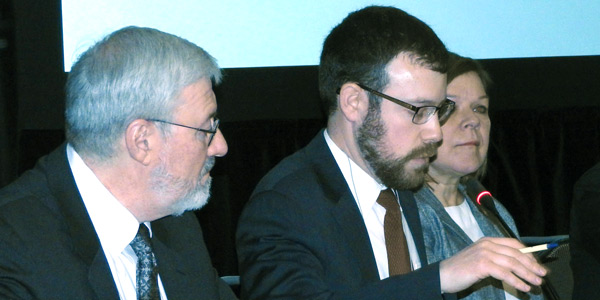By Rory D. Sweeney
WASHINGTON — While FERC has given states a wide berth for determining the avoided-cost rate for qualified facilities under the Public Utility Regulatory Policies Act, other regulatory inconsistencies and utility “recalcitrance” have hindered the law’s implementation, a panel of experts told regulators this week at the National Association of Regulatory Utility Commissioners’ winter meeting.
PURPA was established in 1978 to diversify the country’s energy supply, increase efficiency, reduce dependence on fossil fuels and develop a market for independent power producers. It requires electric utilities to purchase the output of cogeneration and small power-production “qualifying facilities” (QFs) at the cost a utility would incur for supplying the power itself or by obtaining supplies from another source. The law leaves it to each state’s utility commission to formulate those “avoided costs.”
No Second-Guessing
“We have been very explicit about this: We are reluctant to second-guess a state’s determination on avoided costs,” said Lawrence Greenfield, a senior attorney at FERC.
The Energy Policy Act of 2005 amended PURPA to allow termination of the must-buy requirements if FERC finds that the QF has nondiscriminatory access to make market sales. The commission has ruled that includes QFs of more than 20 MW that participate in RTO markets. (See FERC: Entergy not Required to Buy from Large QFs.)
Greenfield noted that the most recent litigation over PURPA has been in non-RTO regions.
“I’m not sure what that says exactly about RTO markets, whether they are more efficient or less efficient, more pro-QF or less pro-QF, but it is an interesting observation that the litigation seems to be concentrated in non-RTO markets,” he said.
He later added that retail choice and resource diversification might draw consumers to other generators “and that might indirectly impact QFs, but we certainly haven’t seen it in the cases we have had.”
Irene Kowalczyk, director of global energy at paper and cardboard manufacturer WestRock, said it’s “probably harder” to get PURPA-based contracts in open-access states because the utilities don’t own the generation and aren’t issuing major requests for proposals.
‘Black Box’ Avoided-Cost Formulas
“In regulated markets, PURPA is somewhat working,” Kowalczyk said, though she added that states’ avoided-cost formulas are often a “black box,” with inconsistent methodologies and no overall framework.
“Notwithstanding the complaint about FERC’s 1-mile rule, today’s complaints about PURPA are nothing new and echo complaints made 30 years ago, when PURPA was initially implemented,” said Ari Peskoe, a senior fellow in electricity law at the Harvard Law School.
The “1-mile rule” requires developers to maintain a 1-mile buffer between projects to qualify them as separate QFs. The commission implemented the provision to prevent developers from “disaggregating” large generation projects into smaller units to qualify under PURPA.
Peskoe argued that much of the blame for slow implementation should be focused on utilities.
“When a utility today claims that it has an abundance of QF energy, I suggest it’s worth investigating how the utilities actions may have contributed to that situation,” he said, noting that many utilities continue to overestimate demand growth in their integrated resource plans. “To what extent utilities’ inaccurate load forecasts, failure to account for those mistakes and lack of foresight about the development of renewable energy technologies contribute to their perceived abundance of QF energy, should the utility be held accountable for these mistakes? How can regulators do so while protecting ratepayers? These are obviously not easy questions to answer, but I suggest they are worth asking.”
Combined Heat and Power
Kowalczyk, who also represented the Industrial Energy Consumers of America, said the rules need to be revised, clarified and standardized across all states so that utilities regard QFs in the proper context.
“The RTO rules treat industrial CHP [combined heat and power] and waste-heat recovery QFs as if they’re merchant power plants that sell power as their primary business,” she said. “To achieve the lowest cost possible for the ratepayers, states should encourage utilities to develop technology-specific avoided cost rates for each resource type. … The minimum term for QF contract should include 10 to 12 years of capacity payments for QFs of all sizes in fully regulated non-RTO areas and in RTO markets for smaller QFs.”
Kowalczyk added that it’s hard for CHP units to perform as capacity resources because their output is entirely dependent upon the steam requirements of plant’s primary manufacturing process. The rule’s inconsistencies have reduced enthusiasm for such projects. “I don’t think any new CHP-type facilities have been installed in those RTO markets … because they can’t get the financing. The RTO markets aren’t sufficient to provide sufficient compensation that is certain to enable those QFs to be built. So what we’ve seen since the passage of the Energy Policy Act of 2005 is a significant reduction in the amount of CHP and waste-heat recovery-type facilities being built.”
Payments to QFs in PJM are often based on energy and capacity clearing prices, she said, though Peskoe noted that courts have ruled that the avoided-cost rate can’t be based on spot-market prices.
Greenfield said FERC prefers that utilities and QFs negotiate mutually agreeable terms, but that it’s also interested in seeing QFs sign long-term agreements. He added that FERC doesn’t have any specific revisions to the law that it would like to see made to the law.
“We at FERC are largely agnostic about changing PURPA,” he said. “Our view is: Whatever Congress tells us to do, that’s what the hell we’re gonna do.”
In a separate NARUC session, acting FERC Chairman Cheryl LaFleur had the same message. Changes that people have asked FERC to make to PURPA rules “are really legislative changes,” she said.




